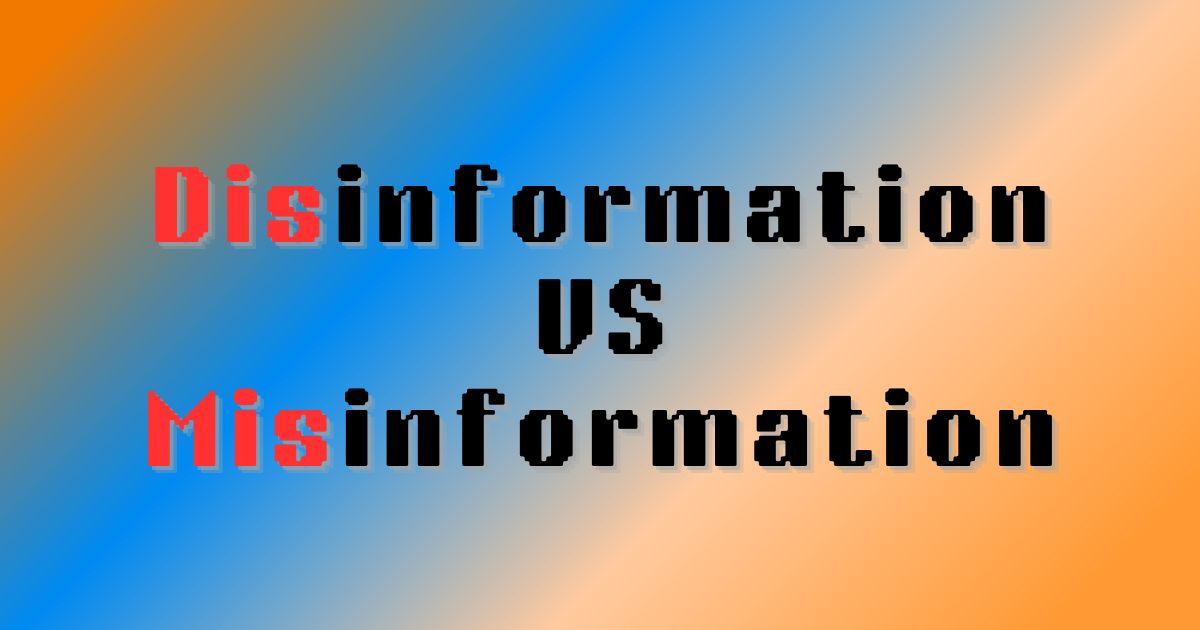In today’s digital age, where information flows freely through a vast network of online platforms, the ability to distinguish between disinformation and misinformation has become an essential skill. While both terms encompass inaccurate information, they differ significantly in their intent and impact.
Disinformation
Disinformation is deliberately created and spread with the intention to deceive, mislead, or harm. It is a weapon used to manipulate public opinion, sow discord, and undermine trust in institutions. Examples of disinformation include:
- Doctored images or videos that portray events differently from reality.
- Fabricated news stories designed to promote a particular political agenda.
- Conspiracy theories aimed at discrediting individuals or groups.
Disinformation campaigns are often orchestrated by sophisticated actors with a vested interest in manipulating public opinion. These actors can include state actors seeking to undermine rival governments, political organizations aiming to influence elections, or even malicious individuals with a personal vendetta. They exploit the vulnerabilities of online platforms and social networks to amplify their reach and impact. Disinformation campaigns can be highly targeted, using social media algorithms and other tools to deliver tailored messages to specific audiences. This makes them particularly dangerous, as they can exploit existing biases and emotional vulnerabilities to spread discord and sow confusion.
Misinformation
Misinformation is false or misleading information that is spread unintentionally. It often stems from misunderstandings, misinterpretations, or lack of fact-checking. Examples of misinformation include:
- Sharing a social media post about a miracle cure without verifying its scientific validity.
- Spreading rumors about a celebrity’s death based on unconfirmed sources.
- Mistakenly attributing a quote to a famous figure.
Misinformation can have a cascading effect, eroding trust in reliable sources of information and making it difficult for people to make informed decisions. For example, during the COVID-19 pandemic, a constant stream of misinformation about the virus and its treatments undermined public health efforts. People bombarded with false claims about the virus’s origins, prevention methods, and cures were less likely to follow public health guidelines such as mask-wearing and social distancing. This, in turn, contributed to the spread of the virus and caused unnecessary illness and death.
Misinformation can also be used to manipulate public opinion on important social and political issues. For instance, social media has been rife with misinformation about climate change, leading some people to doubt the scientific consensus on the issue. This can have a significant impact on policy decisions, as public support is often essential for enacting meaningful climate change legislation.
Why Distinguishing Matters
The difference between disinformation and misinformation is not just a matter of semantics. It has profound implications for how we consume and share information. While misinformation can often be addressed through education and fact-checking initiatives, disinformation requires a more complex approach. Countering disinformation effectively requires media literacy, critical thinking skills, and vigilance against malicious actors. Here’s why:
- Misinformation can be spread by anyone, even those who are simply mistaken or have been exposed to inaccurate information themselves. Disinformation, on the other hand, is typically created and disseminated by actors with a specific agenda, such as swaying public opinion or undermining trust in institutions. These actors often employ sophisticated techniques to make their disinformation appear credible, making it more difficult to detect and debunk.
- Misinformation can sometimes be corrected through educational efforts that teach people how to evaluate information critically. Fact-checking organizations can also play a role in debunking misinformation by exposing false claims and providing accurate information. However, disinformation campaigns often target specific populations with tailored messages that exploit existing biases or emotional vulnerabilities. This makes them more resistant to traditional fact-checking methods.
- Misinformation may not always be created with the malicious intent to deceive. Disinformation, by contrast, is inherently manipulative. It is designed to sow discord, spread panic, or undermine trust in legitimate sources of information. The consequences of disinformation can be far more severe than those of misinformation, as it can erode the very foundation of a healthy democracy.
Examples in the Real World
The COVID-19 pandemic has been a breeding ground for both misinformation and disinformation. False claims about the virus’s origins, prevention methods, and treatments have spread rapidly online, undermining public health efforts. For instance, social media was flooded with conspiracy theories suggesting the virus was a bioweapon or a hoax. This misinformation discouraged people from taking necessary precautions like mask-wearing and social distancing, leading to a rise in infections and deaths.
Disinformation campaigns have targeted specific populations with tailored messages to exacerbate social divisions and erode trust in healthcare institutions. Anti-vaccine propaganda, for example, discouraged people from getting vaccinated, hindering efforts to achieve herd immunity and control the spread of the virus. The ease with which such misinformation and disinformation can spread online highlights the importance of media literacy and critical thinking skills. By being discerning consumers of information and verifying sources before sharing, we can help mitigate the harmful effects of these campaigns.
Political disinformation campaigns have become a major threat to democratic processes around the world. They can be used to sow discord among voters, undermine trust in legitimate candidates and institutions, and ultimately influence the outcome of elections. For example, during the 2016 US presidential election, social media was rife with fake news stories and conspiracy theories aimed at discrediting Hillary Clinton. This disinformation campaign likely played a role in swaying public opinion and contributed to Donald Trump’s victory.
Disinformation campaigns can also be used to exacerbate social divisions and create political instability. By spreading false information about ethnic or religious groups, for instance, disinformation actors can stoke tensions and incite violence. This can have a devastating impact on societies, leading to unrest and even civil war.
Understanding the difference between misinformation and disinformation is essential for protecting ourselves from these manipulative tactics. By being critical consumers of information, verifying sources, and supporting reliable media outlets, we can help to ensure that democracy and truth prevail.


